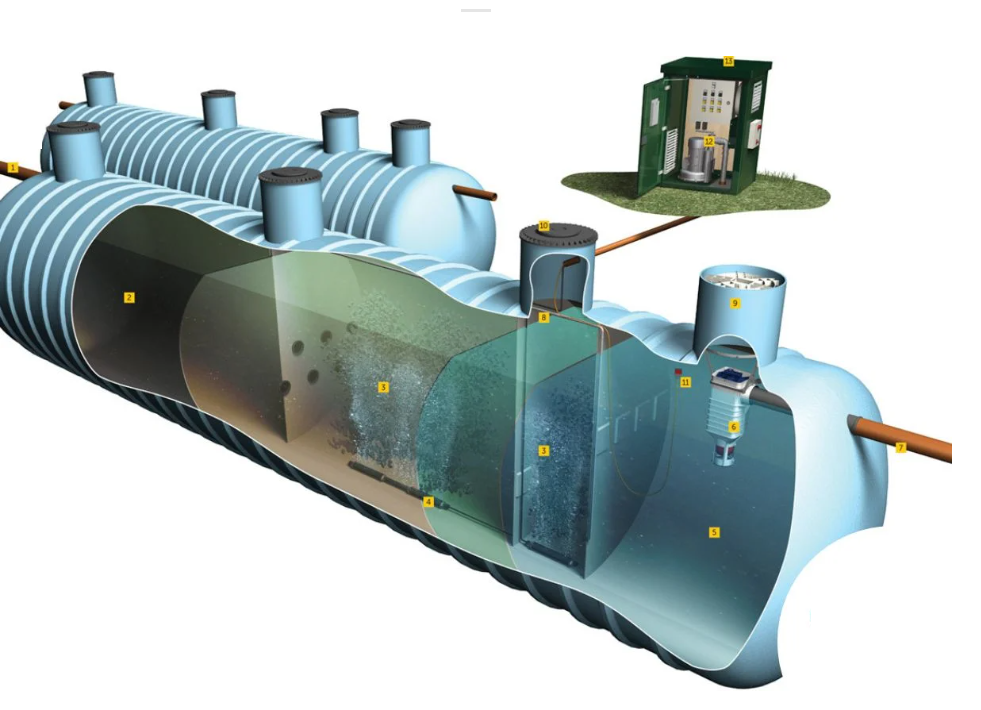
Internal sewage treatment plant
An inland sewage treatment plant is the most viable and widely preferred option. While the vast majority of the world’s population depends on the main sewer system to drain waste away from their property. It is estimated that around 5% of homes and residences need to rely on outdoor solutions due to their rural or out-of-town location. There are a number of options available for such cases, including a septic tank, cesspool, or an indoor wastewater treatment plant.
Despite being the most effective solution, there are still many factors to consider before choosing to install a domestic wastewater treatment plant.
Main sources
Sewage treatment plants are a popular choice for rural properties that are not connected to the main sewer systems.
Domestic sewage treatment plants operate by cleaning sewage waste through sedimentation, aeration, and decontamination processes.
Maintenance and upkeep of domestic wastewater treatment plants is important to ensure that they operate properly and meet environmental regulations.
Advantages of the sewage treatment plant
One of the main reasons why domestic wastewater treatment plants tend to be the more popular option is that they are fairly low maintenance and usually less expensive. However, they can only be installed in conjunction with the absorption system. This is because current legislation stipulates that septic tanks should not be discharged into a natural water source due to pollution and environmental damage. As a result, septic tanks are unsuitable for use in areas where the ground is not porous enough to accommodate a septic system.
In addition to meeting environmental regulations, municipal wastewater treatment plants also tend to be cheaper to run over a longer period of time. Although the initial outlay costs may be higher. This is because they generally need to be emptied on an annual basis only because they have collected a very low level of sludge thanks to the treatment process itself. Other septic systems need to be emptied frequently which can quickly increase operating costs. Treatment plants are also the most environmentally friendly solution for dealing with sewage waste in a rural setting because they do not discard ammonia, which can be harmful to wildlife and the surrounding natural habitat. The resulting uncontaminated wastewater discharged by wastewater treatment is usually about 95% of the plants clean.
How do treatment plants work?
While septic tanks and ponds are used to collect and store sewage waste until it can be emptied during routine service. Sewage treatment plants actually clean it, hence the name. So that it can be emptied without causing contamination or damage to the surrounding area.
This is done through three main treatment stages, which start with sedimentation in the first chamber inside the plant. Gravity is used so that the liquid waste floats to the top and is then separated from the solid waste by filter machines. The remaining sludge – the industry term generally used to describe solid waste – is then stored until the treatment plant has been professionally serviced and the solids have been removed for disposal, while the liquids are moved along the plant’s aeration chambers.
The ventilation stage involves introducing compressed air into the room via an electrically driven pump (or multiple pumps in some cases). Which raises the level of oxygen content in the effluent. This facilitates the growth of beneficial bacteria that clear the effluent. Once the wastewater has been decontaminated and the bacteria settle. The bacteria are transferred to the first chamber for later removal while the treated wastewater is ready to be discharged into either a local natural water source such as a river or stream, or a fixed soak system.
The appropriate size
Different sizes of wastewater treatment systems are available depending on local requirements, so it is important that you choose the right size for the job. In addition to considering the size of the house or property from which the wastewater will be sent. You must also estimate the number of people who will benefit from the household facilities. Which can include toilets, sinks, bathrooms, and showers. In general, for a single property with no more than three bedrooms, you should allow a minimum number of occupants of five. For homes with more than three bedrooms. You should start with a base of five and add an extra person each with an extra bedroom – the same calculation can also apply where there is a block of two buildings.
For larger groups of up to 25 people. The calculation changes and it is recommended to multiply the number of residents or facility users by 0.9 instead to give you the final total. Where there are between 26 and 50 people, this should be adjusted to 0.8.
For commercial settings such as offices or factories. It is usually recommended that you look to install a system that can accommodate waste based on about a third of the size of the workforce. This is because employees are expected to use much fewer waste-producing facilities than residents. However, you should always seek advice from the specific supplier or manufacturer of the plant before committing to a purchase.
For commercial properties, you should also check that the waste that is generated can be classified as a household. According to the Environment Agency, this excludes effluents from chemical toilets, lavatories, commercial cooking facilities, and municipal or commercial swimming pools.
Choose the perfect location
Once you are confident that you know what size your local sewage plant needs to be, you will need to plan its location. The Building Regulations state that any type of sewage treatment plant must be more than seven meters from the foundations of any property or holiday homes and at least ten meters from a stream.
Although everyday odors from the waste treatment solution are not usually very strong. Odor is definitely a factor during the vacuuming process and as with any electrically powered system. It also generates a fairly quiet but constant noise. I recommend you keep these points in mind when deciding on a site. The accessibility of the station must also be considered so that it can be easily emptied when needed. Wherever possible, locating a plant on a slope from waste sources can help take advantage of gravity and increase the efficiency of the wastewater treatment process.
Equipment requirements
In addition to calculating the size of the wastewater treatment plant that you will need. You will also need to assess how many sewage pumping stations the system will need. and waste treatment plant, and the required depth of underground drainage pipes. In addition, you will need to make sure that you have an electricity source.
Install the system
Domestic wastewater treatment plants should only be installed by fairly experienced professionals. Because any errors can cause harm to residents, property, wildlife, and the surrounding environment. The job also includes several necessary steps, including testing the surrounding soil. Calculate the amount of piping work required, and connect the wastewater treatment system to a power source. And excavating a large area of land in which to install the system.
Ongoing maintenance
Once your municipal wastewater treatment plant is established, it must be carefully maintained to ensure that it continues to operate as required. Although you should check the instructions provided by the system manufacturer. However, it is generally recommended that WWTPs be serviced at least once a year. This usually involves removing solid waste so that it can be properly disposed of off-site. As well as checking for the correct level of microorganisms within the system to ensure that the discharged effluent is treated appropriately.
It is also essential to ensure that any wastewater treatment systems are properly protected from rainwater and are adequately sealed throughout. Although a little rain may seem relatively harmless. However, any additional water sources added to the treatment system are likely to disrupt bacterial growth and the decontamination process. Which is harmful to the system and means that you may inadvertently pollute the environment with contaminated waste. In some cases, rainwater may also flood your tanks which can be an annoying problem to deal with.
Finally, you need to ensure that your treatment plant is being used properly for its intended purpose. This means making sure that the items that will cause the blockage are not carelessly disposed of inside the house or the building opposite. This includes bulky items such as diapers, baby wipes, and sanitary products, as well as food waste. They are all common causes of blockages within any type of drainpipe system and must be eliminated by an alternative method. It is also recommended to avoid using antibacterial cleaning products because of the chemicals they contain. By design, it is likely to offset the balance of bacteria within the wastewater treatment system and affect how effectively it treats the waste before it is discharged.
If you’re not sure which solution is right for you and want some expert recommendations, our customer service team is ready to answer any questions you may have – get more information on any of the products or treatment plant models we’ve already carried out.

























